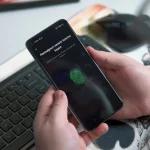Can fingerprints be hacked? Yes. This is the new method of 2024
One of the biggest concerns in the cybersecurity field is fingerprints.
How to hack fingerprints?
Researchers have successfully devised a method to replicate an individual’s fingerprints by analysing the sound produced during a touchscreen swipe. This breakthrough, achieved by a collaborative effort between teams in the US and China, carries significant implications for the field of biometric security, encompassing applications in smartphones and door access systems.
Termed as PrintListener, the technique reconstructs the distinctive pattern of a finger’s papillary lines using the acoustic signals generated as it moves across a screen. The researchers caution that hackers could exploit the smartphone’s built-in microphone to capture these sounds, thereby pilfering a victim’s fingerprint.
In their detailed paper on the findings, the researchers highlighted the potential risks associated with widespread fingerprint leakage, including theft of sensitive information, substantial economic and personnel losses, and even potential compromises to national security. They underlined the extensive and covert nature of the PrintListener attack, emphasizing its ability to record fingertip friction sounds through various social media platforms.
In practical scenarios, the researchers achieved a partial reconstruction of a person’s fingerprint 27.9% of the time and a full reconstruction 9.3% of the time using PrintListener. The research, titled ‘PrintListener: Uncovering the vulnerability of fingerprint authentication via the finger friction sound,’ was authored by a team from the University of Colorado in the US and Tsinghua University, Wuhan University, and Huazhong University of Science and Technology in China.
Proposed measures to mitigate the risk of fingerprint cloning include the use of specialised screen protectors on mobile devices. However, the researchers also suggest the exploration of new sound analysis techniques. Additionally, altering user behaviour, such as refraining from swiping fingers on phone screens during audio and video calls on social media platforms, is recommended as an effective countermeasure.
The global fingerprint biometrics market is poised to reach nearly $75 billion by 2032, according to a recent report from Allied Market Research, a substantial increase from $21 billion in 2022. The report acknowledges that this projection could be influenced by operational concerns related to privacy and security.
What is PrintListener and how does it work?

PrintListener is a technique developed by researchers from the US and China. It recreates a person’s fingerprints by analysing the sound generated when their finger swipes across a touchscreen. The acoustic signals produced during this action are used to reconstruct the pattern of the finger’s papillary lines.
What protective measures are suggested against fingerprint cloning?
The researchers propose protective measures such as using specialised screen protectors on mobile devices. They also recommend exploring new sound analysis techniques. Additionally, altering user behaviour, such as refraining from swiping fingers on phone screens during audio and video calls on social media platforms, is considered an effective countermeasure.
Can multiple fingerprints be registered on a single phone?
Yes, most smartphones with fingerprint technology allow users to register multiple fingerprints. This feature is useful for users who want to grant access to trusted individuals, such as family members or close friends.
Can someone hack into a phone using fingerprint replication?
While phone fingerprint technology is generally secure, recent research has shown that hackers could potentially replicate fingerprints by recording the sound of a finger swiping across a touchscreen. It’s crucial to stay informed about such advancements and follow recommended security measures.
